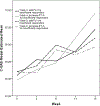Critical Decision Points for Augmenting Interpersonal Psychotherapy for Depressed Adolescents: A Pilot Sequential Multiple Assignment Randomized Trial
- PMID: 30577943
- PMCID: PMC7549148
- DOI: 10.1016/j.jaac.2018.06.032
Critical Decision Points for Augmenting Interpersonal Psychotherapy for Depressed Adolescents: A Pilot Sequential Multiple Assignment Randomized Trial
Abstract
Objective: Practice parameters recommend systematic assessment of depression symptoms over the course of treatment to inform treatment planning; however, there are currently no guidelines regarding how to use symptom monitoring to guide treatment decisions for psychotherapy. The current study compared two time points (week 4 and week 8) for assessing symptoms during interpersonal psychotherapy for depressed adolescents (IPT-A) and explored four algorithms that use the symptom assessments to select the subsequent treatment.
Method: Forty adolescents (aged 12-17 years) with a depression diagnosis began IPT-A with an initial treatment plan of 12 sessions delivered over 16 weeks. Adolescents were randomized to a week 4 or week 8 decision point for considering a change in treatment. Insufficient responders at either time point were randomized a second time to increased frequency of IPT-A (twice per week) or addition of fluoxetine. Measures were administered at baseline and weeks 4, 8, 12, and 16.
Results: The week 4 decision point for assessing response and implementing treatment augmentation for insufficient responders was more efficacious for reducing depression symptoms than the week 8 decision point. There were significant differences between algorithms in depression and psychosocial functioning outcomes.
Conclusion: Therapists implementing IPT-A should routinely monitor depression symptoms and consider augmenting treatment for insufficient responders as early as week 4 of treatment.
Clinical trial registration information: An Adaptive Treatment Strategy for Adolescent Depression. https://clinicaltrials.gov; NCT02017535.
Keywords: algorithms; depression; fluoxetine; psychotherapy; symptom assessment.
Copyright © 2018 American Academy of Child and Adolescent Psychiatry. Published by Elsevier Inc. All rights reserved.
Conflict of interest statement
Disclosure: Dr. Mufson has received royalties from Guilford Press, Inc. for the book,
Figures





Comment in
-
Adaptive Interventions Are Required for Efficient and Personalized Adolescent Depression Treatment.J Am Acad Child Adolesc Psychiatry. 2019 Jan;58(1):16-17. doi: 10.1016/j.jaac.2018.07.892. Epub 2018 Nov 13. J Am Acad Child Adolesc Psychiatry. 2019. PMID: 30577932
References
-
- Brent DA, Baugher M, Bridge J, Chen T, Chiappetta L. Age- and sex-related risk factors for adolescent suicide. J Am Acad Child Adolesc Psychiatry. 1999;38: 1497–1505. - PubMed
-
- Glied S, Pine DS. Consequences and correlates of adolescent depression. Arch Pediatr Adolesc Med. 2002;156:1009–1014. - PubMed
-
- Lewinsohn PM, Roberts RE, Seeley JR, Rohde P, Gotlib IH, Hops H. Adolescent psychopathology II: psychosocial risk factors for depression. J Abnorm Psychol. 1994; 103:302–315. - PubMed
-
- Birmaher B, Brent D. Practice parameter for the assessment and treatment of children and adolescents with depressive disorders. J Am Acad Child Adolesc Psychiatry. 2007;46: 1503–1526. - PubMed
Publication types
MeSH terms
Substances
Associated data
Grants and funding
LinkOut - more resources
Full Text Sources
Medical

